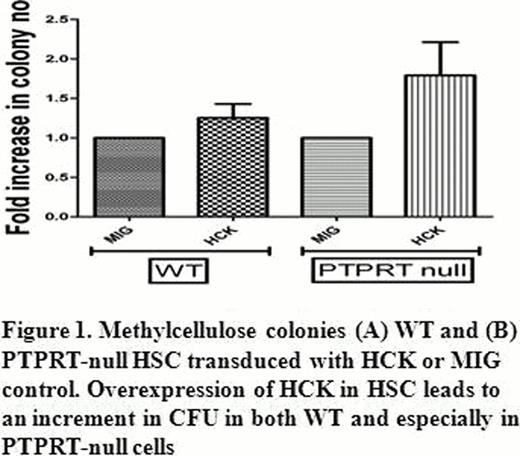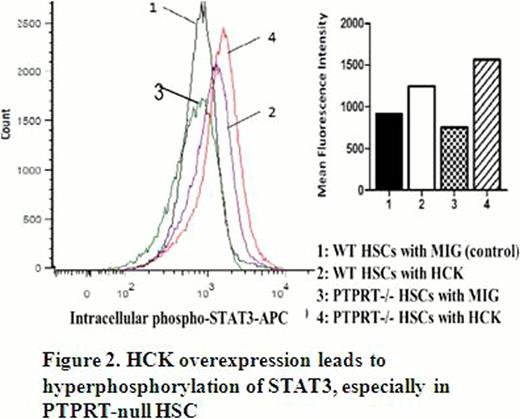Abstract
Abstract 1324
Deletion of the long arm of chromosome 20 [del(20q)] is a common recurrent chromosomal abnormality in acute myeloid leukaemia (AML). It is a key step in AML development and a better understanding of the associated molecular events is important. The abnormal chromosome 20 in del(20q) AML has been shown to have lost a “Common Deleted Region” (CDR) that contains Protein Tyrosine Phosphatase Receptor T (PTPRT), a tyrosine phosphatase that is mutated in many human cancers such as AML. We have previously reported (MacKinnon et al, Genes, Chromosomes and Cancer 2010) that del(20q) also harbours an amplified “Common Retained Region,” (CRR) which contains Haemopoietic Cell Kinase (HCK). HCK is anoncogenic Src tyrosine kinase and its aberrant activation has been shown to contribute to the pathogenesis of some haematological malignancies.
We hypothesize that the amplification of HCK in the CRR cooperates with the loss of PTPRT in the CDR to cause AML. Our model proposes that AML occurs either through direct interaction between HCK and PTPRT, or through aberrant activation of Signal Transducer and Activator of Transcription 3 (STAT3), a cytoplasmic second messenger that is important in cellular signalling. Constitutively activated STAT3 has been shown to be oncogenic in several malignancies, including AML. STAT3 is a direct target of both HCK and PTPRT. It is phosphorylated (hence activated) by HCK, and dephosphorylated (hence inactivated) by PTPRT. This provides a downstream leukaemogenic pathway for our model. The ultimate aim of our experiments is to prove this hypothesis using mouse models. Murine haemopoietic stem cells (HSC) were isolated from the bone marrows of wild type C57BL/6 (WT) and PTPRT-null mice by Fluorescence Activated Cell Sorting for Lineage negative, C-kit and Sca-1 positive (LKS+) cells. Retroviral constructs of HCK were generated by cloning it into the retroviral vector pMSCViresEGFP(MIG), with GFP as reporter. Murine HSC were transduced with either retroviral HCK or MIG vector control and Phoenix cell system was used for retroviral packaging. Experiments using isolated LKS+ HSC were performed to examine for features of AML.
Examination of bone marrow cells from del(20q) AML patients by quantitative PCR revealed an increase in HCK mRNA expression and a reduction in PTPRT expression. Wild type (WT) and PTPRT-null murine HSC transduced with either MIG or HCK were cultured in methylcellulose media. Colony forming units (CFU) were enumerated on day7 and day12. We found that both WT and PTPRT-null HSC transduced with HCK showed a significant increase in colony numbers compared to MIG transduced HSC. Furthermore, the fold increment in colony number was higher in the PTPRT-null genotype as shown in figure 1.
Moreover, an intracellular anti-phosphoSTAT3 assay was performed to assess STAT3 phosphorylation levels in the transduced HSC. It demonstrated that in both WT and PTPRT-null HSC that have been transduced with HCK, STAT3 hyperphosphorylation, and hence overactivation, occured. This response was again more exaggerated in the PTPRT-null HSC, as seen in figure 2.
We are currently transplanting transduced LKS+ HSC (either MIG or HCK) into lethally irradiated murine recipients to assess AML formation in a reconstitution study. The recipient mice will be assessed for evidence of engraftment and subsequent AML.
The preliminary data reveals a likely new oncogenic-signalling cascade: that HCK amplification and loss of PTPRT in del(20q) AML may cooperate to cause AML directly, or by aberrant activity of hyperphosphorylated STAT3.
No relevant conflicts of interest to declare.
Author notes
Asterisk with author names denotes non-ASH members.



